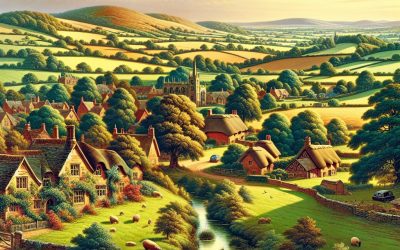Explore the World Through Geography, Natural Resources & Daily History
Clear, reliable and engaging guides that help you understand our planet — from UK geography education to global natural resources and On This Day history events.
Explore, discover, and learn about the wonders of our world! At Earth Site, we’re passionate about bringing geography, history, and science to life for curious minds of all ages. Whether you’re delving into historical events, uncovering the mysteries of the natural world, or seeking interactive resources, you’re in the right place.
Here, you can uncover the stories behind historical events, explore the natural wonders of our planet, and gain valuable insights into how the Earth’s systems shape our daily lives. From the towering peaks of mountain ranges to the far-reaching impacts of human innovation, we aim to make every topic both engaging and informative.
Start your journey of discovery with us today, and let’s make learning an adventure!
What We Cover
Earth Site brings together engaging and accessible educational content designed to help you understand the world, its history, and its natural systems.
🌍 Geography Education (UK & Worldwide)
We publish clear, easy-to-understand geography resources for students, teachers and curious learners. Our guides support geography education in the UK and cover physical geography, climate, ecosystems, population, and global development.
⛏️ Natural Resources & Environmental Geography
Explore detailed country profiles covering natural resources, mining, energy, geology and global environmental challenges. We show how nations manage minerals, water, land and ecosystems, and why these resources matter.
📅 On This Day in History
Every day has a story. Our On This Day history series features major events, anniversaries, traditions, and cultural milestones from around the world — with timelines, context, and fun facts.
TIMELINE
Exploring the Properties and Applications of Cesium (Cs) in Modern Science and Technology
Cesium (Cs) is a chemical element with the atomic number 55 and the symbol Cs. It is a soft, silvery-gold alkali metal that is highly reactive and has unique properties. Cesium is the most electropositive and alkaline element, and it is one of the least abundant elements in the Earth’s crust. Physically, cesium is a soft metal that can be easily cut with a knife. It has a low melting point of 28.5 degrees Celsius, which makes it one of the few metals that are liquid at or near room temperature. Cesium also has a high density, which gives it a unique weight and feel compared to other metals. Chemically, cesium is highly reactive and can react explosively with water. It is also highly corrosive and can react with many other elements and compounds. Cesium has a single valence electron, which makes it highly reactive and gives it unique chemical properties. Cesium has various applications in different industries due to its unique properties. It is used in atomic clocks for precise timekeeping, in medical imaging for diagnostic purposes, as a catalyst in chemical reactions, in nuclear energy and reactors, in spacecraft propulsion, in the production of glass and optics, in the development of quantum computers, and as a tracer in environmental studies. Summary Cesium (Cs) has unique properties that make it useful in a variety of applications. Cesium (Cs) is used in atomic clocks and timekeeping due to its high accuracy. Cesium (Cs) is used in medical imaging and cancer treatment to target and destroy cancer cells. Cesium (Cs) is a catalyst in chemical reactions, increasing reaction rates and...
Northumberland, England
Northumberland, located in the northeast of England, is a hidden gem that offers a unique experience for travelers. With its rich history, stunning coastline, and beautiful national park, Northumberland has something for everyone. Whether you’re interested in exploring historical sites, enjoying outdoor activities, or immersing yourself in the local culture, Northumberland has it all. Northumberland is known for its rugged landscapes and picturesque countryside. It is bordered by Scotland to the north and the counties of Cumbria and Durham to the west and south respectively. The region has a long and fascinating history, with evidence of human habitation dating back thousands of years. From Roman forts to medieval castles, Northumberland is steeped in history. Summary Northumberland is a hidden gem in Northern England with rich history, stunning coastline, and unique culture. The region boasts a rich heritage, including Hadrian’s Wall and Alnwick Castle, which are must-visit attractions. Northumberland’s coastline and beaches are breathtaking, with spots like Bamburgh Castle and Holy Island being popular tourist destinations. Nature lovers will find Northumberland National Park a haven, with its diverse wildlife and stunning landscapes. Northumberland’s culture and traditions are unique, with events like the Northumbrian Gathering celebrating the region’s heritage. Discovering Northumberland’s Rich History and Heritage Northumberland is home to a wealth of historical sites and landmarks that offer a glimpse into its past. One of the highlights is Hadrian’s Wall, a UNESCO World Heritage Site that was built by the Romans in the 2nd century AD. Stretching for 73 miles across the region, it is one of the most iconic landmarks in Britain. In addition to Hadrian’s Wall, Northumberland is...
Northamptonshire, England
Northamptonshire is a county located in the East Midlands region of England. It is bordered by eight other counties, including Warwickshire, Leicestershire, and Bedfordshire. With a population of over 700,000 people, it is one of the most populous counties in England. Summary Northamptonshire is a county located in central England with a rich history dating back to Roman times. The county boasts stunning natural beauty with its countryside and parks, perfect for exploring and outdoor activities. Northamptonshire is home to numerous museums, galleries, and historic sites that showcase its cultural heritage. The county is known for its delicious local cuisine and breweries, as well as its sporting legacy in football, rugby, and motorsports. Northamptonshire offers a diverse shopping experience with both high street brands and independent boutiques, and hosts a variety of festivals and events throughout the year. The History of Northamptonshire: From Roman Times to Present Day Northamptonshire has a rich history that dates back to Roman times. The Romans occupied the area and established a settlement known as Lactodorum, which later became the town of Towcester. The Romans also built several roads and forts throughout the county. During the Anglo-Saxon period, Northamptonshire was part of the Kingdom of Mercia. The county played a significant role in the Norman Conquest of England in 1066, with several battles taking place in the area. The Normans built castles and churches throughout Northamptonshire, many of which still stand today. In more recent history, Northamptonshire played a crucial role in the Industrial Revolution. The county was known for its iron and steel industries, as well as its shoemaking industry. Today, Northamptonshire...
Shining a Light on Xenon: The Fascinating Element with Illuminating Properties
Xenon is a chemical element with the symbol Xe and atomic number 54. It is a rare and noble gas that belongs to the group of elements known as the noble gases. Xenon is a colourless, odourless, and tasteless gas that is found in trace amounts in the Earth’s atmosphere. It is one of the least reactive elements and is known for its stability and inertness. In the periodic table, xenon is located in Group 18, also known as the noble gases or inert gases. This group consists of helium, neon, argon, krypton, xenon, and radon. The noble gases are characterized by their low reactivity and full outer electron shells, making them stable and unreactive. Xenon is the heaviest of the noble gases and has the highest atomic number. Xenon is considered a rare gas because it is found in very small quantities in the Earth’s atmosphere. Its abundance in the atmosphere is approximately 0.0000087%. Despite its rarity, xenon has a variety of unique properties that make it valuable in various applications. Summary Xenon is a rare and noble gas with unique properties that make it useful in a variety of applications. Xenon was discovered in 1898 by Sir William Ramsay and Morris Travers. Xenon’s properties, such as its high density and low reactivity, make it useful in lighting, medical imaging, and space exploration. Xenon is used in high-intensity discharge lamps for its ability to produce bright, white light. Xenon flash tubes are commonly used in photography for their ability to produce short, intense bursts of light. The Discovery of Xenon: A Brief History Xenon was discovered by Scottish...
Norfolk, England
Norfolk is a county located in East Anglia, England. It is known for its rich history, natural beauty, and cultural highlights. With its stunning coastline, picturesque countryside, and charming towns and villages, Norfolk offers a diverse range of attractions for visitors to explore. Summary Norfolk is a county in England with a rich history dating back to Roman times. Visitors can explore top attractions such as Norwich Cathedral and Sandringham Estate. Norfolk’s natural beauty includes stunning coastline and countryside perfect for outdoor activities. The county’s food and drink scene features local produce and fine dining options. Cultural highlights include museums, galleries, and theatres, while festivals and events celebrate Norfolk’s heritage. History of Norfolk: From Roman Times to the Present Day Norfolk has a fascinating history that dates back to Roman times. The county was once part of the Roman province of Britannia and was home to several important settlements, including the town of Venta Icenorum, which was the capital of the Iceni tribe. During the Anglo-Saxon period, Norfolk became an important center of trade and commerce. The town of Norwich, which is now the county’s capital, was founded by the Anglo-Saxons in the 5th century and quickly grew into a thriving city. In the Viking era, Norfolk was frequently raided by Viking invaders. The county’s strategic location on the east coast made it an attractive target for Viking ships. However, the Vikings were eventually defeated by the Anglo-Saxons and Norfolk remained under English control. Norfolk played a significant role in the Industrial Revolution, with many towns and villages becoming centers of industry and manufacturing. The county’s ports and...
Middlesex, England
Middlesex, located in the southeast of England, is a county with a rich history that dates back centuries. Originally established as a Saxon settlement, Middlesex has played a significant role in shaping the history and culture of England. From its picturesque countryside to its historic landmarks and vibrant cultural scene, Middlesex offers visitors a diverse range of experiences. In this blog post, we will explore the beauty of Middlesex’s countryside, discover its top attractions, delve into its cultural scene, learn about its role in the Industrial Revolution, celebrate its notable figures, and immerse ourselves in its local festivals and events. We will also explore Middlesex’s sporting heritage and provide tips for planning your visit to this fascinating county. Summary Middlesex is a county with a rich history, dating back to the Roman era. The countryside of Middlesex is beautiful and offers plenty of opportunities for outdoor activities. Middlesex has a range of top attractions, from historic landmarks to modern marvels. Visitors to Middlesex can enjoy a variety of shopping, eating, and drinking experiences. Middlesex has a vibrant cultural scene, with museums, galleries, and theatres to explore. Exploring the Beautiful Countryside of Middlesex Middlesex is blessed with beautiful countryside that offers a peaceful escape from the hustle and bustle of city life. The county is home to numerous parks, gardens, and nature reserves that are perfect for nature lovers. One such place is Richmond Park, a vast expanse of greenery that is famous for its deer population. Visitors can enjoy leisurely walks or bike rides through the park while taking in the stunning views of the surrounding landscape. Another...
Iodine: The Unsung Hero of British Health
Iodine is a vital nutrient that plays a crucial role in the human body. It is essential for the production of thyroid hormones, which regulate metabolism and growth. Iodine is also important for brain development, especially during pregnancy and infancy. In the UK, iodine deficiency has become a growing concern, with many individuals not getting enough of this important nutrient. This article will explore the importance of iodine in the British diet, the risks associated with iodine deficiency, and how to ensure an adequate intake of iodine. Summary Iodine is a vital nutrient for British health, playing a crucial role in thyroid function and brain development. Iodine deficiency is a growing concern in the UK, with many people not getting enough of this essential mineral in their diets. The thyroid gland relies on iodine to produce hormones that regulate metabolism, growth, and development. Adequate iodine intake during pregnancy is essential for ensuring a healthy start for both mother and baby. Tips for getting enough iodine in your diet include eating iodine-rich foods like seafood and dairy products, and using iodized salt. The Importance of Iodine in the British Diet Iodine is a trace mineral that is necessary for the proper functioning of the thyroid gland. The thyroid gland produces hormones that regulate metabolism, growth, and development. Without adequate levels of iodine, the thyroid gland cannot produce enough hormones, leading to a condition called hypothyroidism. Symptoms of hypothyroidism include fatigue, weight gain, and depression. In addition to its role in thyroid health, iodine is also important for brain development. During pregnancy and infancy, iodine is crucial for the development...
Merseyside, England
Merseyside is a county located in the North West of England. It is named after the River Mersey, which runs through the county and has played a significant role in its history and development. The county is home to several major cities and towns, including Liverpool, the largest city in Merseyside and one of the most famous cities in the UK. Other notable cities and towns in Merseyside include Birkenhead, St Helens, and Southport. Summary Merseyside is a metropolitan county in the North West of England, with a population of over 1.4 million people. The region has a rich history, from its role in the Industrial Revolution to its vibrant cultural scene today. Merseyside has a temperate maritime climate, with mild winters and cool summers. The area is known for its contributions to music, literature, and film, with famous artists such as The Beatles and Willy Russell hailing from the region. Merseyside is home to several successful sports teams, including Liverpool and Everton football clubs, as well as a thriving tourism industry. History of Merseyside: From Industrial Revolution to Today Merseyside has a rich history that dates back centuries. It played a crucial role in the Industrial Revolution, with its ports and waterways becoming major hubs for trade and industry. Liverpool, in particular, became one of the world’s leading ports during this time, with goods from all over the world passing through its docks. Over time, Merseyside has evolved and adapted to changing economic and social conditions. The decline of traditional industries such as shipping and manufacturing in the late 20th century led to significant challenges for the...
Lincolnshire, England
Located in the East Midlands region of England, Lincolnshire is a county with a rich history and stunning natural beauty. It is bordered by several counties including Norfolk, Cambridgeshire, and Nottinghamshire. The county has a diverse landscape, ranging from rolling hills and picturesque countryside to charming coastal towns and beautiful beaches. Lincolnshire has a fascinating history that dates back thousands of years. It was once inhabited by the Celts and later became part of the Roman Empire. The county is also known for its connections to the medieval period, with many castles and historic sites still standing today. Lincoln Cathedral, one of the most iconic landmarks in the county, is a testament to the rich history of Lincolnshire. In addition to its historical significance, Lincolnshire is also known for its natural beauty. The Lincolnshire Wolds, an Area of Outstanding Natural Beauty, is a stunning landscape of rolling hills, picturesque valleys, and charming villages. The Fens, on the other hand, offer a unique and tranquil environment with its flat marshlands and waterways. Summary Lincolnshire is a county with a rich history and natural beauty. The countryside of Lincolnshire, from the Wolds to the Fens, is full of charm and beauty. Lincolnshire’s coastal towns and beaches are gems waiting to be explored. The cultural heritage of Lincolnshire is diverse, from medieval castles to modern art galleries. Lincolnshire’s food and drink scene is a must-try, with local delicacies and traditional ales. Discovering the Charm of Lincolnshire’s Countryside: From the Wolds to the Fens One of the highlights of visiting Lincolnshire is exploring its beautiful countryside. The Lincolnshire Wolds, often referred to...
Uncovering the Wonders of Tellurium: A Deep Dive into the Properties and Applications of Element Te
Tellurium, a chemical element with the symbol Te and atomic number 52, is a rare metalloid that was discovered in the late 18th century. It was first identified by Franz-Joseph Müller von Reichenstein, an Austrian mineralogist, in 1782. Reichenstein found tellurium in a gold ore sample from Transylvania and named it after the Latin word “tellus,” meaning Earth. Tellurium is a relatively rare element in the Earth’s crust, occurring at an abundance of about 0.001 parts per million. It is often found in association with other elements such as gold, silver, copper, and lead. The main sources of tellurium are the ores of copper, lead, and gold. It is also found in some rare minerals such as calaverite and sylvanite. In terms of its physical properties, tellurium is a brittle, silvery-white metalloid that has a metallic luster when freshly cut. It has a relatively low melting point of 449 degrees Celsius and a boiling point of 988 degrees Celsius. Tellurium is a semiconductor and exhibits both metallic and non-metallic properties. It is a poor conductor of heat and electricity but becomes a good conductor when exposed to light. Summary Tellurium is a rare metalloid element that was discovered in 1782 by Franz-Joseph Müller von Reichenstein. It is found in small quantities in the Earth’s crust and is often extracted as a byproduct of copper and lead refining. Tellurium has unique physical and chemical properties, including high electrical conductivity and a wide bandgap, which make it useful in a variety of industrial applications. The element has potential applications in energy storage, metallurgy, and electronics, and ongoing research is exploring new...
Leicestershire, England
Leicestershire, located in the heart of England, is a county that is rich in history, natural beauty, and cultural offerings. From its Roman roots to its bustling modern cities, Leicestershire has something to offer everyone. In this blog post, we will explore the diverse attractions and experiences that make Leicestershire a must-visit destination. Whether you are interested in exploring its historical landmarks, immersing yourself in its natural beauty, or indulging in its vibrant cultural scene, Leicestershire has it all. Summary Leicestershire has a rich history dating back to Roman times and boasts famous landmarks such as castles, cathedrals, and stately homes. The county is home to beautiful parks, reserves, and waterways, making it a great destination for nature lovers. Leicestershire has a thriving cultural scene with art, music, and theatre events happening throughout the year. Visitors can enjoy the best shopping and dining experiences in Leicestershire, with a range of options to suit all tastes and budgets. Sports fans can discover Leicestershire’s sporting heritage, including football, cricket, and rugby, while festival-goers can enjoy top events throughout the year. The History of Leicestershire: From Roman Times to the Present Day Leicestershire has a long and fascinating history that dates back to Roman times. The county was once an important Roman settlement and evidence of this can still be seen today in the form of the Jewry Wall and the remains of the Roman baths. Throughout the centuries, Leicestershire has been home to many key historical events and figures. One such figure is King Richard III, whose remains were famously discovered under a car park in Leicester in 2012. The...
Lancashire, England
Lancashire is a county located in the North West of England. It is bordered by the counties of Cumbria to the north, Greater Manchester to the east, Merseyside to the south, and North Yorkshire to the east. Lancashire has a rich history that dates back to Roman times, and it played a significant role in England‘s industrial revolution. The county of Lancashire has a long and fascinating history. It was originally part of the Kingdom of Northumbria, but it later became part of the Kingdom of Mercia. In the 12th century, Lancashire became a county in its own right, and it was granted a royal charter by King Henry Lancashire played an important role in the Wars of the Roses, with battles taking place in the county. Lancashire’s industrial revolution began in the late 18th century with the growth of the cotton industry. The county became known as the “workshop of the world” due to its large number of cotton mills. These mills were powered by water from rivers and streams, and they produced vast quantities of cotton goods that were exported around the world. The cotton industry brought great wealth to Lancashire and transformed it into one of the most industrialized regions in England. Summary Lancashire is a historical county in North West England with a rich industrial heritage. The county boasts beautiful countryside, including the Trough of Bowland and the Forest of Bowland. Lancashire’s coastal towns and cities, such as Blackpool and Morecambe, are popular tourist destinations. The county has a vibrant cultural scene, with a focus on literature, music, and art. Lancashire is known for its...










